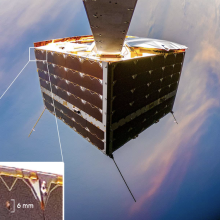Bang!
Astronomers suspect that in the first second after the universe formed, the very first black holes also formed. These tiny though profoundly dense objects — think of an atom-sized particle wielding the mass of a mountain — are dubbed "primordial black holes." But there's a problem: There's still no evidence they've ever existed.
Now, scientists have proposed a novel idea: Perhaps the proof is in front of us, here on Earth.
In new research published in the journal Physics of the Dark Universe, researchers conclude the ancient objects could have left observable proof in the form of microscopic tunnels, or even in hollowed-out objects beyond our planet like asteroids. Though the chance of finding micro-tunnels on Earth is likely small, they may be present in places around us, like the rocks, glass, and metal of buildings — particularly old buildings.
"The most difficult thing to see is what stands right in front of your nose," Dejan Stojkovic, a professor of physics at the University at Buffalo who coauthored the research, told Mashable.
Black holes are almost unimaginably dense. If Earth was (hypothetically) crushed into a black hole, it would be under an inch across. Today, many black holes form following the collapse of massive objects like stars, notably after violent supernova explosions. The objects themselves aren't rare: There are probably 100 million rogue black holes wandering our Milky Way Galaxy alone.
But looking for the first black holes in space has been fruitless. While astronomers can spot large black holes with telescopes — because these objects accrete large amounts of rapidly spinning matter around them that radiate bounties of energy — primordial black holes are too small to accrue such matter. What's more, black holes are believed to emit a type of energy called Hawking radiation, which should be especially intense in small black holes, but that hasn't been detected either. Yet physicists theorize they must be out there.
"Direct observational evidence for small black holes still does not exist, but according to our theories of the early universe, they should be produced generically without invoking any exotic physics," Stojkovic said.
"The most difficult thing to see is what stands right in front of your nose."
So Stojkovic proposed the unique idea of using microscopes to look for tiny tunnels on Earth, created by small, though forceful, primordial black holes. (They would leave holes like a speeding bullet traveling through a wall of glass.) Looking in older materials provides the best odds, simply because such things have been around for ages and have had more opportunity for a black hole impact. It's also much cheaper to look for tunnels than building a new, extremely sensitive detector, especially in a scientific field where funding is tight and deeply competitive — even for NASA.


"Examining old materials for microscopic tunnels should be only a small fraction of the cost of building a dedicated astrophysical detector [which usually costs millions and even billions of dollars]," Stojkovic explained. "Any place on Earth is a priori equally likely to be hit by a small black hole."
The chances of finding a tunnel is "very small," he noted, but such is the reality of sleuthing for evidence left by these ancient, elusive, and minuscule particles. Stojkovic noted that physicists are also hunting for extremely rare "magnetic monopoles" — another hypothesized particle — with expensive detectors. Sure, it's proven hard to find a magnetic monopole, but the scientific payoff would be huge.
However thrilling it would be to discover a black hole micro-tunnel on our planet, the researchers also suggest looking elsewhere in our solar system. More specifically, at relatively small objects like a moon or asteroid with a liquid core (Jupiter's moon Ganymede, for example, has a liquid core). A primordial black hole speeding through space could impact such an object, use its strong gravitational power to soak up the core, and ultimately, after escaping, leave just a hollow crust.

Such a hollowed-out object, the researchers calculated, couldn't be larger than about one-tenth of Earth's radius (meaning some 400 miles) or it would collapse. Crucially, telescopes can reveal an object's movement and mass. "If the object’s density is too low for its size, that’s a good indication it's hollow,” Stojkovic said separately, in a university statement.
These are indeed novel ideas. But the unsuccessful quest for primordial black holes might require offbeat thinking. I asked Stojkovic if anyone before had attempted to look for these micro-tunnels on Earth.
"Not that we are aware of," he said. "Perhaps nobody thought of it yet."
Topics NASA













